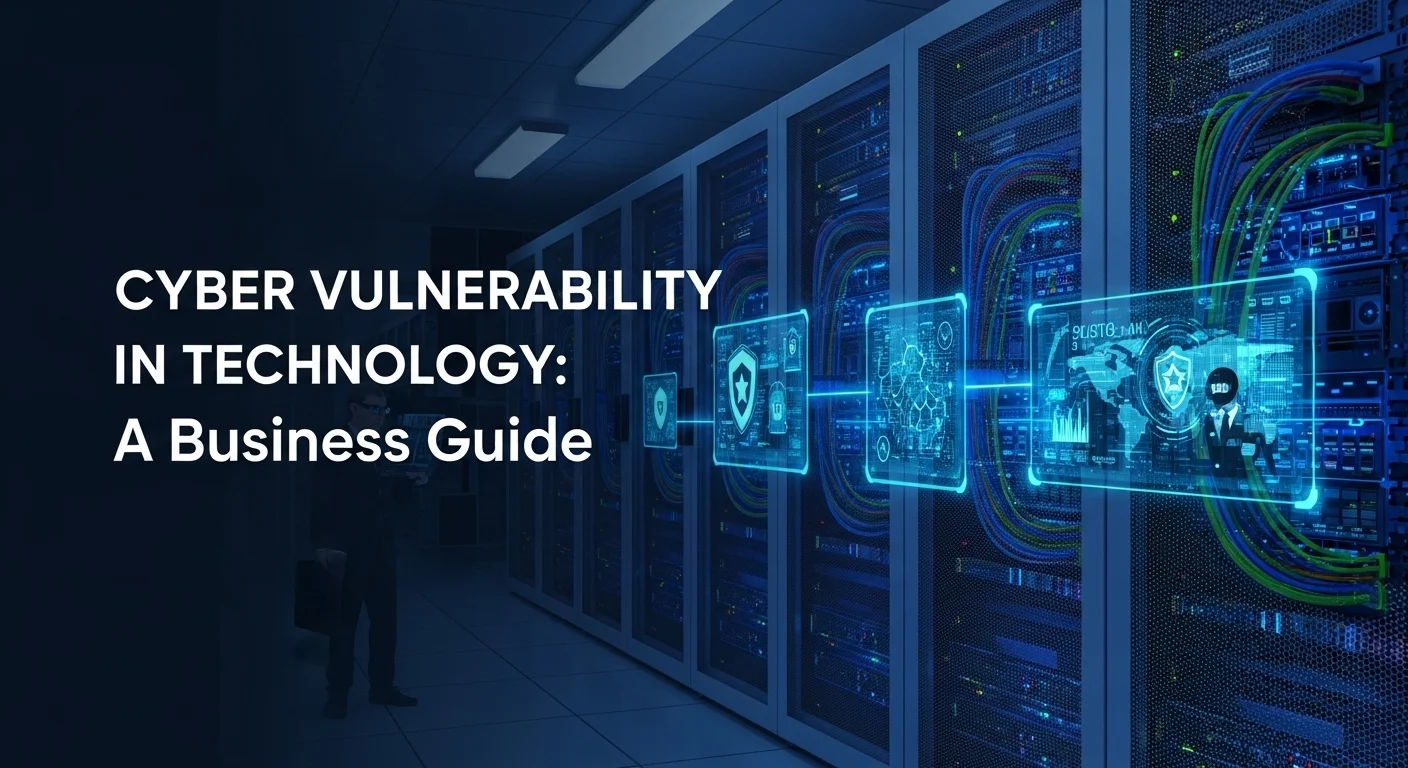Is Your Business Digitally Exposed? A Straight-Talk Guide to Cyber Vulnerabilities

Executive Summary
In our rush to embrace technology, it's incredibly easy to accidentally leave a digital door unlocked. In my world, we call that unlocked door a 'cyber vulnerability.' Think of it as a weakness—a tiny crack in your digital armor that a hacker can exploit to cause major headaches, from devastating data breaches to serious financial ruin. I want to be clear: this isn't just an 'IT problem'; it's a fundamental business risk that can affect your bottom line and reputation. In this guide, I'll walk you through what these vulnerabilities are in plain English. We'll skip the dense jargon and focus on what you, as a business leader, truly need to know. We'll cover how to find these weaknesses through practical assessments and how to manage them continuously, turning your defense from a panicked reaction into a core business strategy. My goal is to help you fortify your operations, so you can lead with confidence in our digital age.
Table of Contents
Table of Contents
- What Exactly Is a Cyber Vulnerability?
- Why This Is So Critical in Today's Hyper-Connected World
- The Business Benefits: Beyond Just Defense
- Understanding the Full Picture: Vulnerabilities, Threats, and Risks
- The Usual Suspects: Common Types of Cyber Vulnerabilities
What is Cyber Vulnerability and why is it important in Technology?
In the complex web of technology we all rely on, the term 'Cyber Vulnerability' is foundational to security. Put simply, it’s a flaw. A weak spot. An oversight in how a piece of technology was designed, built, or set up. I've seen them everywhere: in the software we use every day, our operating systems, our networks, and even in the human processes we follow. It's the digital 'chink in the armor' that, if found by someone with bad intentions, can be used to cause real damage. This could mean someone gaining access to your private customer data, shutting down your website, or installing malicious software like ransomware. Understanding this is crucial because almost every successful cyberattack starts with one of these weaknesses. If there's no vulnerability to exploit, the attacker's efforts go nowhere. That's why finding and fixing these flaws is the absolute bedrock of good security.
The Critical Importance in a Hyper-Connected World
The need to manage these vulnerabilities has exploded as businesses have gone digital. Today, most companies operate on a complex mix of technologies—cloud services, Internet of Things (IoT) devices, AI systems, and sprawling corporate networks. Every new laptop, app, or smart device you connect to your network adds another potential entry point for an attacker. We call this the 'attack surface.' A single unpatched server, a poorly configured cloud storage account, or a weak password on a sensor can be the one opening an attacker needs. And the fallout goes way beyond a technical glitch. A successful attack can lead to crippling financial losses, a damaged reputation that's hard to rebuild, hefty legal fines for not protecting data, and the theft of your company's most valuable secrets. In this environment, having a structured plan to manage vulnerabilities isn't just a technical best practice; it's a core business survival skill.
Business Applications: From Defense to Competitive Advantage
So, how does managing vulnerabilities play out in the real world? The most obvious application is defense—protecting your company’s data and systems. This is done through a continuous cycle of finding, analyzing, prioritizing, and fixing weaknesses. A key part of this is the vulnerability assessment, which is basically a systematic health check of your IT systems. It tells you where you're exposed, how serious the issues are, and what you need to do to fix them. By doing these checks regularly, you get a clear picture of your risk level and can focus your resources on the most urgent problems first.
But the benefits don't stop at defense. Over the years, I've seen companies turn a strong security program into a real competitive advantage. When you can prove your business is secure, you earn trust from customers, partners, and investors. In many industries, you can't even bid for a contract without demonstrating robust security. Furthermore, when you build security into your products from the start (a practice we call DevSecOps), you create more reliable products, lower the long-term cost of fixing issues, and can actually get to market faster. This proactive mindset transforms security from a roadblock into something that helps your business grow. An initial vulnerability assessment is the first step on this journey, giving you the map you need to build a truly resilient company.
Understanding the Full Picture: Vulnerabilities, Threats, and Risks
To really get a handle on this, it helps to understand the key players in this space: vulnerabilities, threats, and risks. We've established a vulnerability is a weakness. A threat is anyone or anything that could exploit that weakness—a hacker, a piece of malware, or even a disgruntled employee. Risk is what happens when the two meet; it’s the potential for damage when a threat exploits a vulnerability. For example, an unpatched server (the vulnerability) sitting in a locked room isn't a huge problem. But when that same server is connected to the internet where hackers (the threat) can find it, the risk of a breach becomes very real.
These vulnerabilities are tracked in public databases, most famously the Common Vulnerabilities and Exposures (CVE) list. When a new flaw is found, it gets a unique CVE ID, which gives everyone a common language to talk about it. This system is vital for organized vulnerability management, as it allows scanning tools to check your systems against a global list of known issues.
The Usual Suspects: Common Types of Cyber Vulnerabilities
Cyber vulnerabilities come in a few common flavors. Knowing them helps you conduct a more thorough security check-up. Here are the ones I see most often:
- Software Bugs: Simple errors in computer code. Things like SQL injection, which lets an attacker trick your website's database into giving up information, are classic examples.
- Misconfigurations: This is probably the most common and frustrating category because it's often so preventable. It's the result of using insecure default settings or making mistakes during setup, like leaving 'admin' as the password or accidentally making a cloud storage folder public.
- Outdated Software: When software companies find a flaw, they release a fix, or a 'patch.' If you don't apply these patches quickly, you're leaving your systems exposed to known exploits. This is how a huge number of ransomware attacks happen.
- Weak or Stolen Credentials: Using simple passwords or reusing the same password everywhere is a huge vulnerability. If an attacker gets a hold of a valid password, they can often just walk right in.
- Zero-Day Vulnerabilities: This is the scariest kind. A 'zero-day' is a flaw that hackers have found, but the software maker doesn't know about it yet. That means there's no patch available, and attackers have a wide-open window to exploit it.
A solid vulnerability management program needs to address all of these. It's about more than just patching; it's about smart configuration, strong password rules, and having a plan for the unexpected. By treating security as a continuous and proactive process, you shift from constantly putting out fires to building a truly resilient business.

A Complete Guide to Managing Cyber Vulnerability: A Practical Framework
A successful approach to managing cyber vulnerabilities isn't a one-time project, but a continuous cycle. I always tell my clients to think of it as a workout routine for their company's digital health. This process, often called the vulnerability management lifecycle, gives you a clear, structured way to shrink your attack surface. It's the engine of any effective security strategy. Let's walk through the five key phases: Discover, Prioritize, Remediate, Verify, and Report.
Phase 1: Discover - You Can't Protect What You Don't Know
The first and most fundamental step is discovery. If you don't know what technology you have, you can't possibly protect it. This phase is all about creating a complete inventory of every single asset in your IT environment. I'm talking servers, laptops, mobile phones, cloud services, applications—everything. Once you have your list, the next step is to perform a vulnerability assessment to find the weaknesses in those assets. This is usually done with a few key tools and techniques:
- Vulnerability Scanners: These are automated tools that scan your network and systems for thousands of known issues, like missing patches, insecure settings, and cataloged CVEs. I always recommend using authenticated scans, where the tool logs into the system, as it provides a much more detailed and accurate picture from the inside out.
- Penetration Testing (Pen Testing): This is where you hire ethical hackers to simulate a real-world attack. A good pen test can uncover complex issues that automated scanners might miss, giving you a brutally honest look at how a real attacker could get in.
- Application Security Testing (SAST/DAST): If you build your own software, these tests are essential. They analyze your application's code and its running behavior to find flaws like SQL injection or Cross-Site Scripting (XSS) before they become a problem.
- Configuration Audits: This involves checking your systems against established security standards, like those from the Center for Internet Security (CIS). It's a great way to catch common misconfigurations that leave you exposed.
This discovery phase is the foundation. Without a complete and accurate map of your assets and their weaknesses, the rest of your efforts will be based on guesswork.
Phase 2: Prioritize - Focusing on What Truly Matters
After a scan, you'll likely get a report with hundreds or even thousands of vulnerabilities. It's easy to feel overwhelmed. Trying to fix everything at once is a recipe for burnout and failure. This is where prioritization comes in, and frankly, it's where most programs either succeed or fail. The goal is to use business context to figure out which vulnerabilities pose the biggest actual risk. Here’s what I look at:
- Severity Score (CVSS): This is a standard score from 0-10 that tells you how technically severe a vulnerability is. It's a good starting point, but it's not the whole story.
- Threat Intelligence: Is this vulnerability being actively used by hackers in the wild right now? Is it part of a popular ransomware attack? This information is gold, as it tells you which flaws are actively being targeted.
- Asset Criticality: This is key. A 'critical' vulnerability on a test server that's not connected to anything is far less important than a 'medium' vulnerability on your e-commerce platform that processes payments. You have to know what your most important assets are.
- Business Impact: What's the worst-case scenario if this gets exploited? Think in terms of lost revenue, reputational damage, and operational downtime.
By layering these factors, you can move beyond the raw technical data and create a priority list that focuses on the issues posing a clear and present danger to your business.
Phase 3: Remediate - Taking Action and Fixing the Flaws
Remediation is the hands-on work of fixing the problems you've identified and prioritized. In my experience, this is often the most challenging phase because it requires tight coordination between your security, IT, and development teams. The main strategies are:
- Patching: This is the most common fix. It simply means applying the security update provided by the software vendor. Having a smooth, reliable patch management process is non-negotiable for good security.
- Configuration Changes: For vulnerabilities caused by bad settings, the fix is to adjust them to a secure state. This could mean closing an open network port, strengthening password requirements, or disabling an old, weak protocol.
- Mitigation: Sometimes, you can't patch a system right away—perhaps it's running a critical process that can't be interrupted. In these cases, you can put other controls in place to reduce the risk. This might involve using a firewall to block attacks or isolating the vulnerable system on its own network segment.
- Risk Acceptance: On rare occasions, the business might decide that the cost or disruption of fixing a flaw outweighs the risk. This should be a formal, documented decision approved by leadership, not just an ignored ticket.
Smooth remediation relies on clear communication and defined timelines for fixing issues based on their priority level.
Phase 4 & 5: Verify and Report - Closing the Loop and Showing Your Work
You're not done until you've confirmed the fix actually worked. The verification phase involves running another scan to make sure the vulnerability is truly gone. I've seen too many cases where a patch installation failed silently, leaving the system just as exposed as before. Always double-check.
Finally, reporting is how you communicate the value of your entire program. You need different reports for different people. Your tech teams need the nitty-gritty details. But your leadership team needs a high-level dashboard that shows the big picture: your overall risk score, trends over time, and how quickly you're fixing critical issues. These reports prove the program is working, justify its budget, and give leadership the data they need to make smart, strategic decisions about security. Following this continuous cycle is how you build and maintain a strong, adaptive defense.

Tips and Strategies to Master Your Tech and Improve Security
Building a truly effective vulnerability management program is about more than just buying software; it's about embedding a security mindset into your company's DNA. The goal is to make proactive defense a natural part of how you operate, instead of constantly reacting to crises. Here are some of the most impactful strategies I share with my clients to elevate their security game.
Strategy 1: Get Organized with a Formal Program
The single most important thing you can do is to formalize your efforts. Just scanning and patching whenever you feel like it is a strategy that's guaranteed to miss things. A formal program creates the structure and authority you need to be successful.
- Define Who Does What: Write down exactly who is responsible for each part of the process. Who runs the scans? Who decides what to fix first? Who deploys the patches? When everyone knows their role, things get done.
- Set Clear Deadlines (SLAs): Create a policy that sets deadlines for fixing vulnerabilities based on their severity. For example, you might decide that critical flaws must be fixed within 7 days, high-severity ones within 30, and so on. This creates accountability.
- Get Leadership on Board: You need support from the top. I always coach my teams to communicate with leadership in terms of business risk (e.g., 'This flaw could cost us $X in downtime') instead of technical jargon. When leaders understand the stakes, they'll give you the budget and backing you need.
Strategy 2: Work Smarter, Not Harder, with Automation
In today's complex tech environments, trying to manage vulnerabilities manually is simply impossible. Automation is the key to scaling your efforts and making them efficient.
- Automate Your Scanning: Don't treat a vulnerability assessment as a once-a-year event. Schedule automated scans to run continuously across your entire network, including remote devices and cloud services. This ensures you always have an up-to-date view of your risks.
- Connect Your Tools: Integrate your vulnerability scanner with your IT helpdesk system (like Jira or ServiceNow). This can automatically create a ticket for the right team as soon as a critical issue is found, cutting down the time from detection to detection.
- Use Patch Management Systems: Deploy tools that can automatically test and deploy security patches across your company. This dramatically reduces the manual workload and is a core part of any modern security strategy.
Strategy 3: Adopt a Risk-Based Mindset
Remember, not all vulnerabilities are created equal. A risk-based approach ensures you're spending your time and money on the threats that pose the biggest danger to your specific business.
- Look Beyond the Score: A CVSS score is just a starting point. You should give higher priority to vulnerabilities on your internet-facing systems, those that affect your most critical applications, and especially those that are being used in active attacks. Many modern security platforms can pull in this threat intelligence automatically.
- Know Your Assets: You can't properly assess risk if you don't know the value of what you're protecting. Maintain a clear inventory of all your technology and assign a 'criticality' level to each asset. This is foundational to making smart decisions.
- Focus on the 'Most Wanted' List: Government agencies like CISA in the US maintain a catalog of 'Known Exploited Vulnerabilities.' This is essentially a list of flaws that hackers are actively using right now. In my opinion, fixing anything that appears on this list should be your absolute top priority. You can find it easily on the CISA website. [9]
Strategy 4: Build a Culture of Security
At the end of the day, technology and processes can only take you so far. Your people are a critical line of defense. When your entire company values security, it makes everything else more effective.
- Integrate Security into Development (DevSecOps): Don't wait until a product is finished to check for flaws. Give your developers the tools to scan their own code as they write it. Finding and fixing flaws early is dramatically cheaper and easier.
- Train Everyone: All employees need to be trained to spot and report security issues. This goes beyond just spotting phishing emails; it's about promoting good habits like using strong passwords and speaking up if something seems off.
- Encourage Collaboration: Security should not be an isolated department that says 'no.' It should be a collaborative effort. When your security, IT, and development teams work together with a shared goal of protecting the business, you create a much stronger and more resilient organization.
By putting these strategies into practice, you can transform your security from a reactive chore into a proactive, risk-based program that not only defends the business but also enables it to grow and innovate safely.
Expert Reviews & Testimonials
Sarah Johnson, Business Owner ⭐⭐⭐
The information about Cyber Vulnerability is correct but I think they could add more practical examples for business owners like us.
Mike Chen, IT Consultant ⭐⭐⭐⭐
Useful article about Cyber Vulnerability. It helped me better understand the topic, although some concepts could be explained more simply.
Emma Davis, Tech Expert ⭐⭐⭐⭐⭐
Excellent article! Very comprehensive on Cyber Vulnerability. It helped me a lot for my specialization and I understood everything perfectly.



